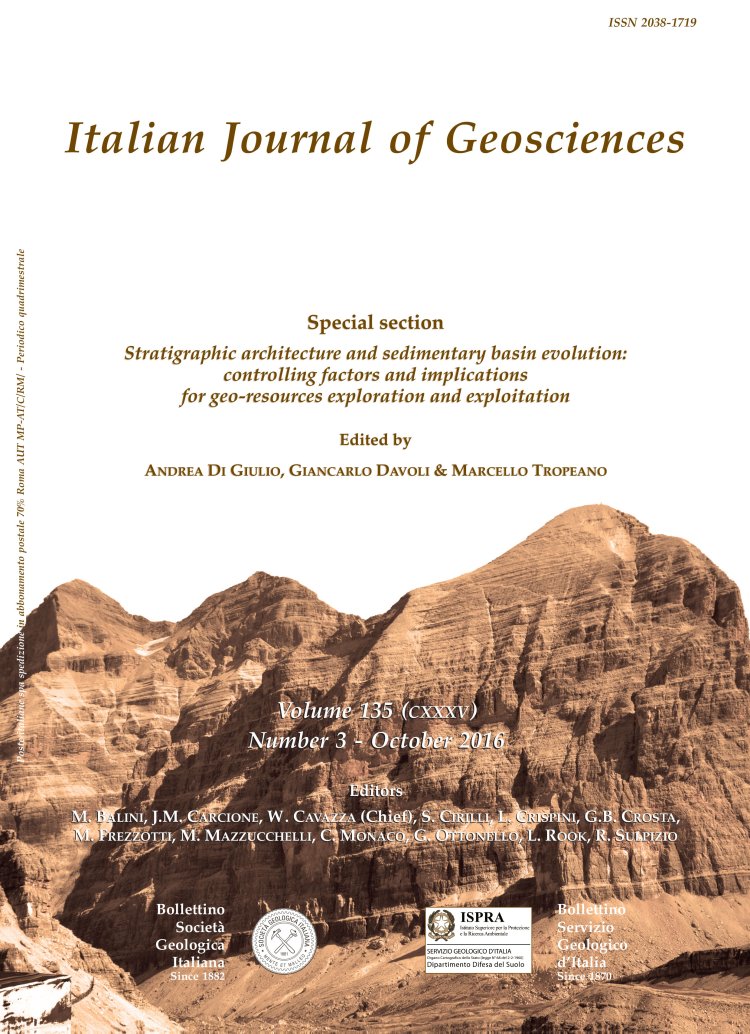
Depositional architecture of a confined, sand-rich submarine system: the Bric la Croce – Castelnuovo turbidite system (Tertiary Piedmont Basin, Oligocene, NW Italy)
Fabrizio Felletti
Dipartimento Scienze della Terra "A.Desio", Università degli Studi di Milano, via Mangiagalli 34, 20133 I-Milano, via Mangiagalli 34, 20133 I-Milano. Tel. +39 02 503 15554. E-mail: fabrizio.felletti@unimi.it
Volume: 135 (2016) f.3
Pages: 365-382
Abstract
Submarine sand-rich slope fans within confined basins have long been recognized as components of deepwater depositional systems and, in some areas, they host important hydrocarbon accumulations. The Bric la Croce – Castelnuovo turbidite system (BCTS) of northern Italy offers an opportunity to study an exposed sand-rich slope fan system, allowing reconstruction of the main architectural elements of a fan, from slope to basin floor. The system belongs to the Langhe Basin, the major depocentre of the TPB (Tertiary Piedmont Basin), an episutural basin set upon a complex of Alpine nappes of the Liguria – Piemonte Western Alps.
The system consists of three main erosional and depositional zones from up- to down-stream (from SE to NW): i) a base of slope zone; ii) a channel-lobe transition zone; iii) a lobe zone. Downslope and upslope migration of these sectors determines, through time, their superimposition and gives rise to a generation of depositional units of different hierarchical order ranging from metre-thick simple facies sequences to decametres composite facies sequence, expression of single and composite architectural elements as channel and lobe complexes. The vertical organisation of the BCTS reflects its overall forestepping. Thin-bedded turbidites interpreted as distal lobes are overlain by stacked sandsheets and aggradational channels attributed to the mid-fan setting. At the top of the series, coarse-grained sandy channels correspond to the maximum of forestepping.
The logged sections and the geological mapping provide a valuable data set that can be used to study the spatial-temporal relationships between facies of channelized and nonchannelized strata (lobe deposits) along a depositional profile, cut roughly parallel to the main palaeocurrent flow. The sands were derived from south and flowed toward the north. The portion of the BCTS which crops out is approximately 160 m thick and extends for about 10-12 km in a SW-NE direction.
Research involved a detailed analysis of facies (genetic facies related to depositional processes), physical stratigraphy of stacking and correlation patterns. The detailed correlation panels allowed evaluating how facies changed along the depositional profile and this was considered as the expression of the flow transformation during its movement. Based on these considerations, it has been possible to reconstruct different facies tracts, which are related to flows with different volume and efficiency recording a coeval phase of sedimentation in the channel, channel-transition and lobe zones.
The system consists of three main erosional and depositional zones from up- to down-stream (from SE to NW): i) a base of slope zone; ii) a channel-lobe transition zone; iii) a lobe zone. Downslope and upslope migration of these sectors determines, through time, their superimposition and gives rise to a generation of depositional units of different hierarchical order ranging from metre-thick simple facies sequences to decametres composite facies sequence, expression of single and composite architectural elements as channel and lobe complexes. The vertical organisation of the BCTS reflects its overall forestepping. Thin-bedded turbidites interpreted as distal lobes are overlain by stacked sandsheets and aggradational channels attributed to the mid-fan setting. At the top of the series, coarse-grained sandy channels correspond to the maximum of forestepping.
The logged sections and the geological mapping provide a valuable data set that can be used to study the spatial-temporal relationships between facies of channelized and nonchannelized strata (lobe deposits) along a depositional profile, cut roughly parallel to the main palaeocurrent flow. The sands were derived from south and flowed toward the north. The portion of the BCTS which crops out is approximately 160 m thick and extends for about 10-12 km in a SW-NE direction.
Research involved a detailed analysis of facies (genetic facies related to depositional processes), physical stratigraphy of stacking and correlation patterns. The detailed correlation panels allowed evaluating how facies changed along the depositional profile and this was considered as the expression of the flow transformation during its movement. Based on these considerations, it has been possible to reconstruct different facies tracts, which are related to flows with different volume and efficiency recording a coeval phase of sedimentation in the channel, channel-transition and lobe zones.
Keywords
Get Full Text